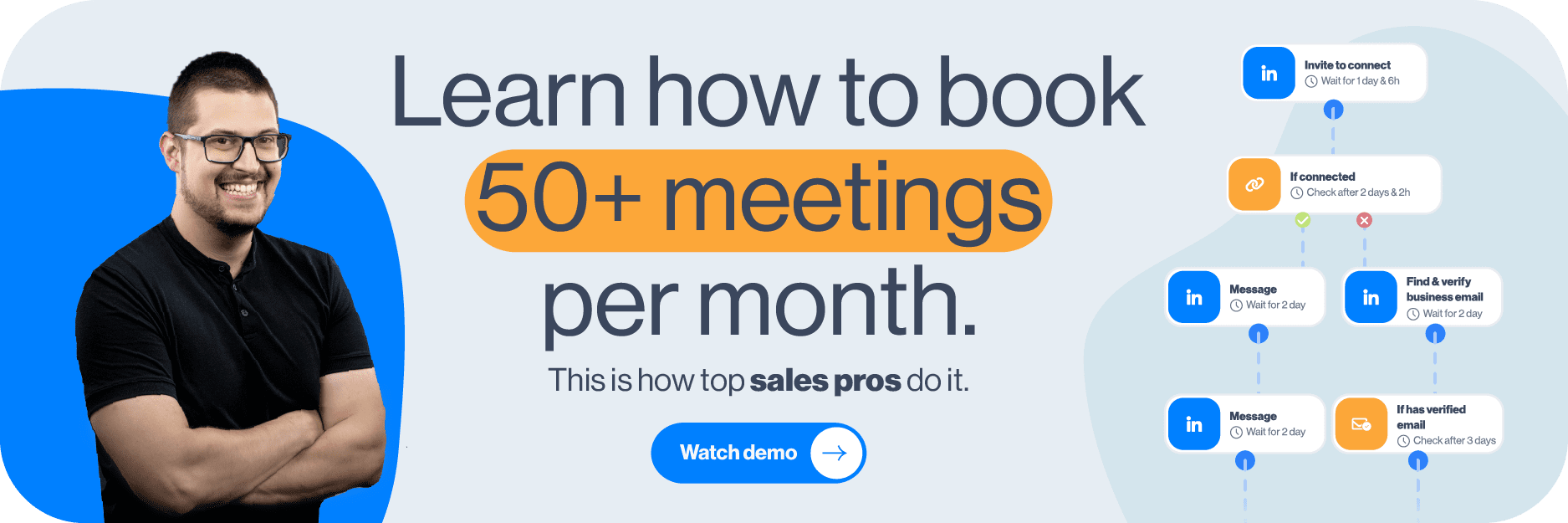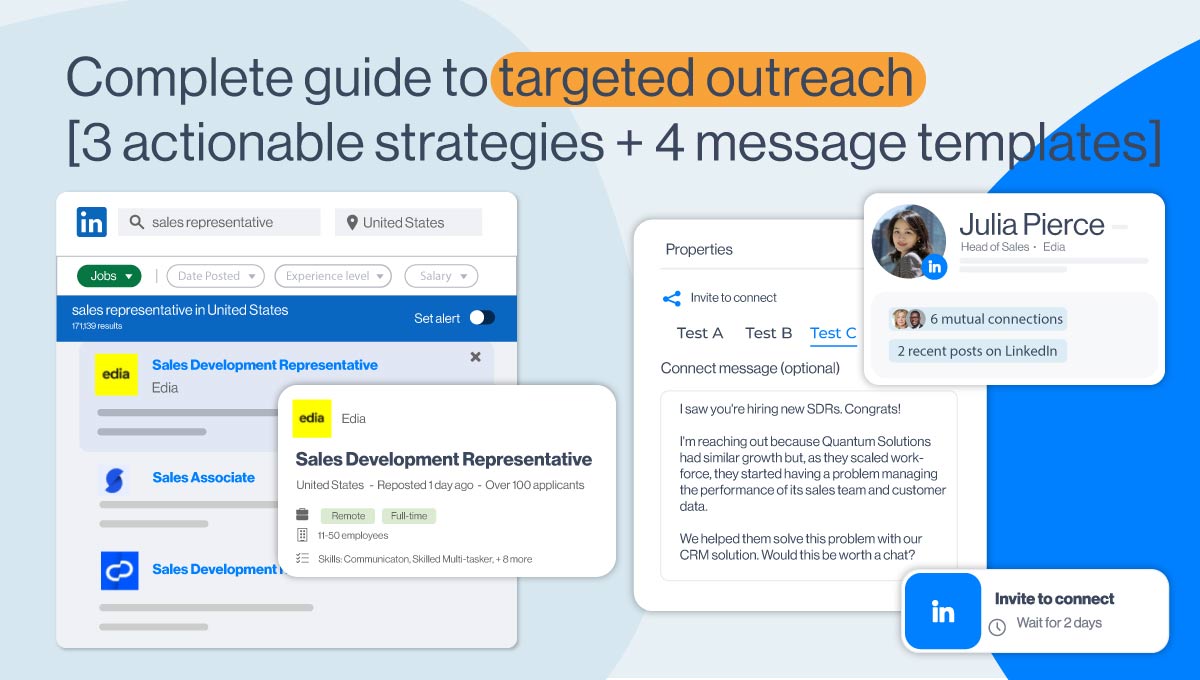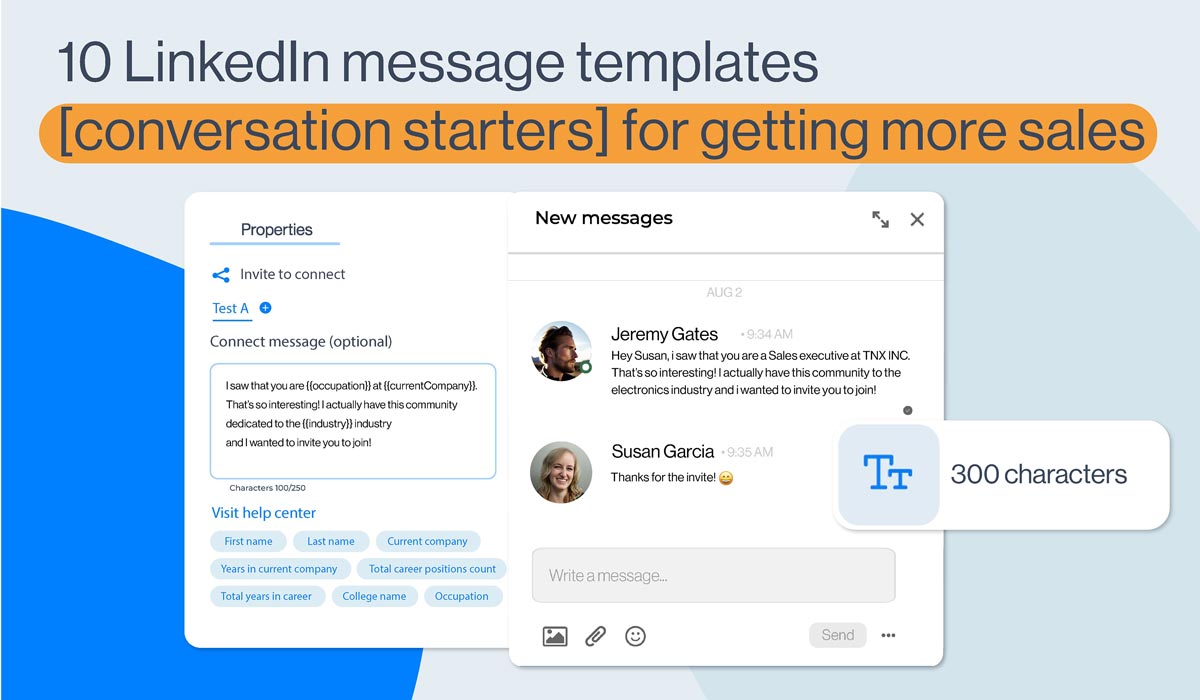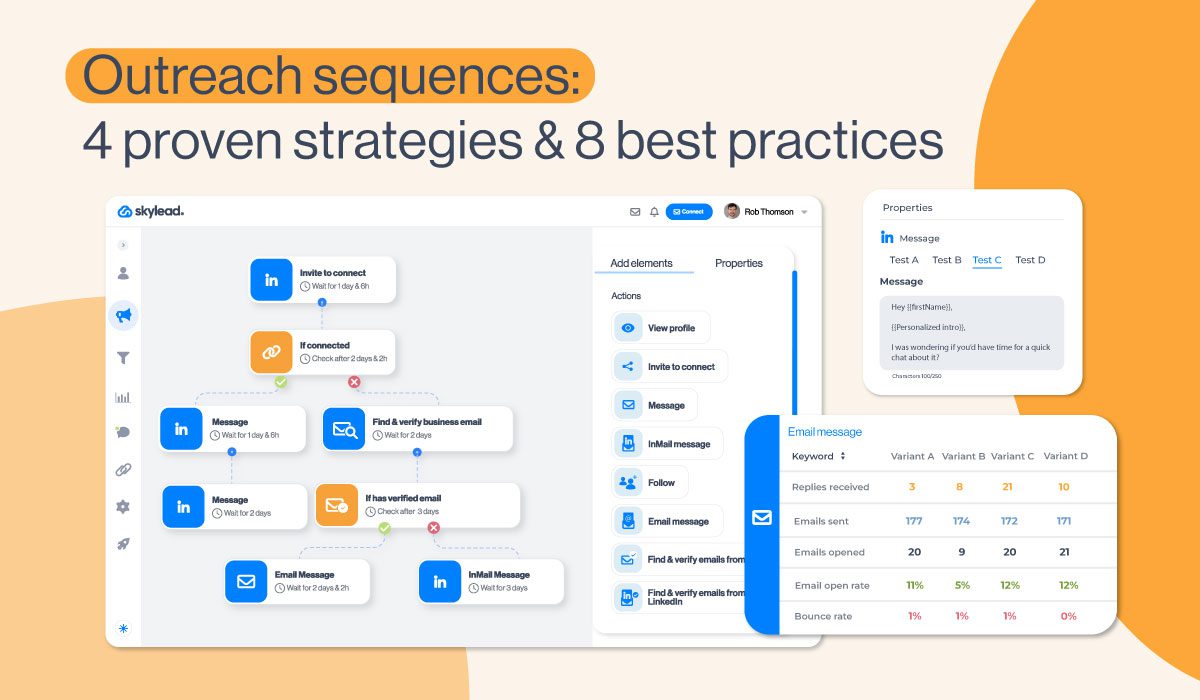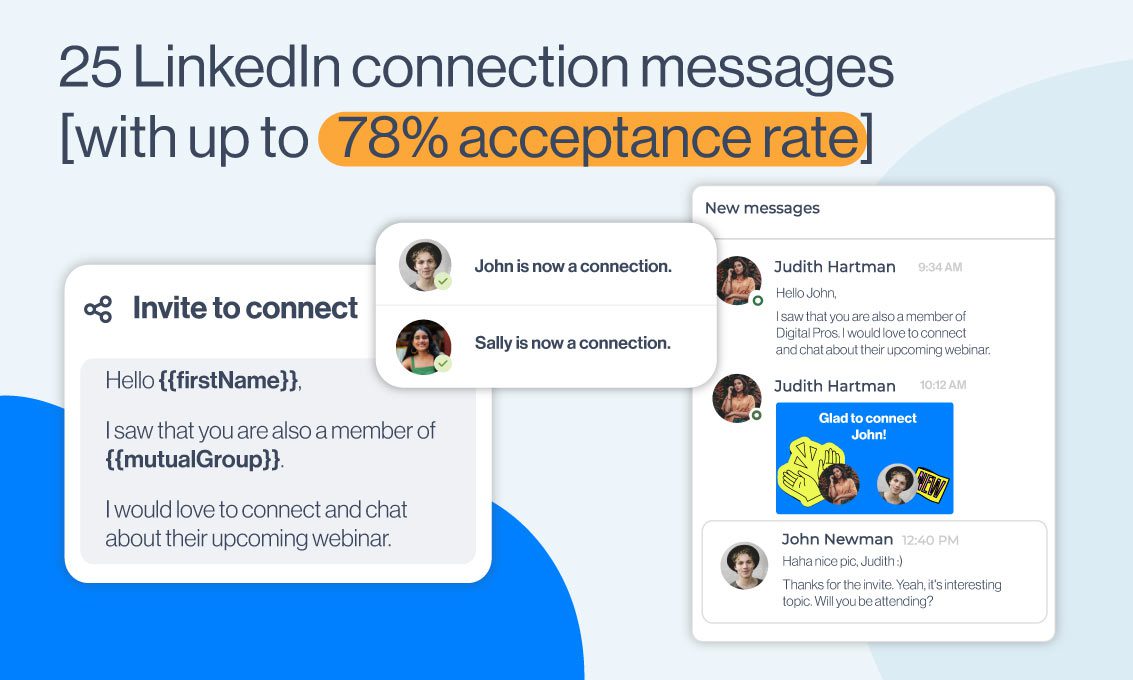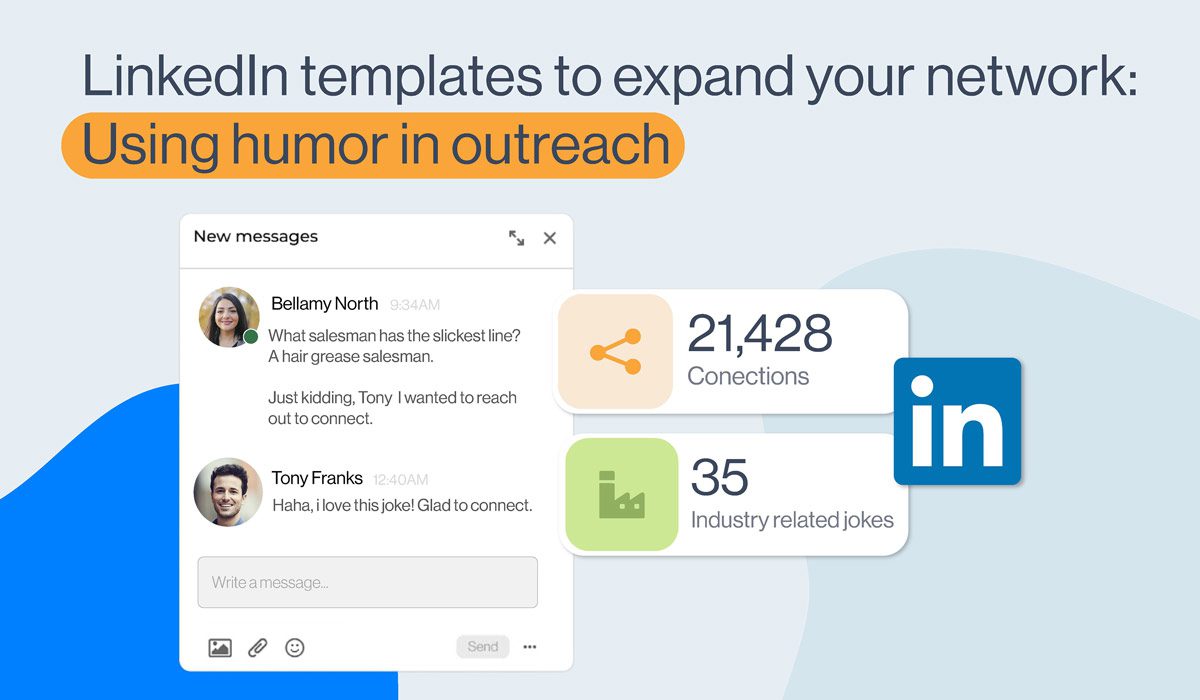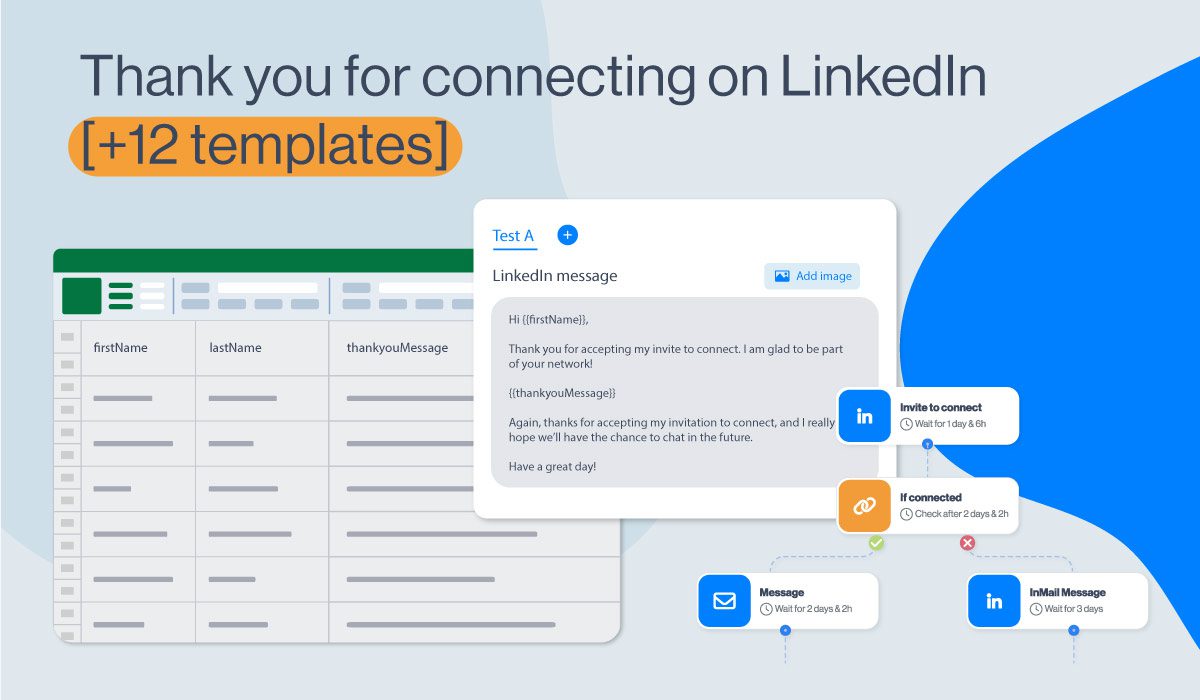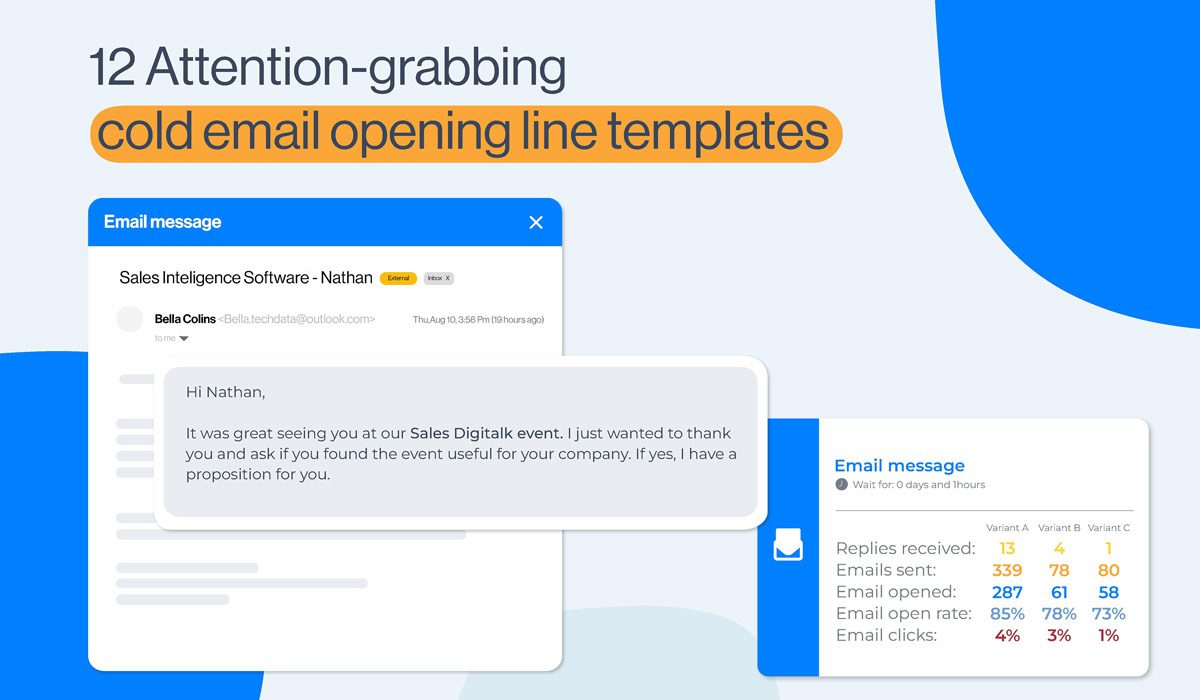Cold outreach: Increase the level of personalization [+templates]
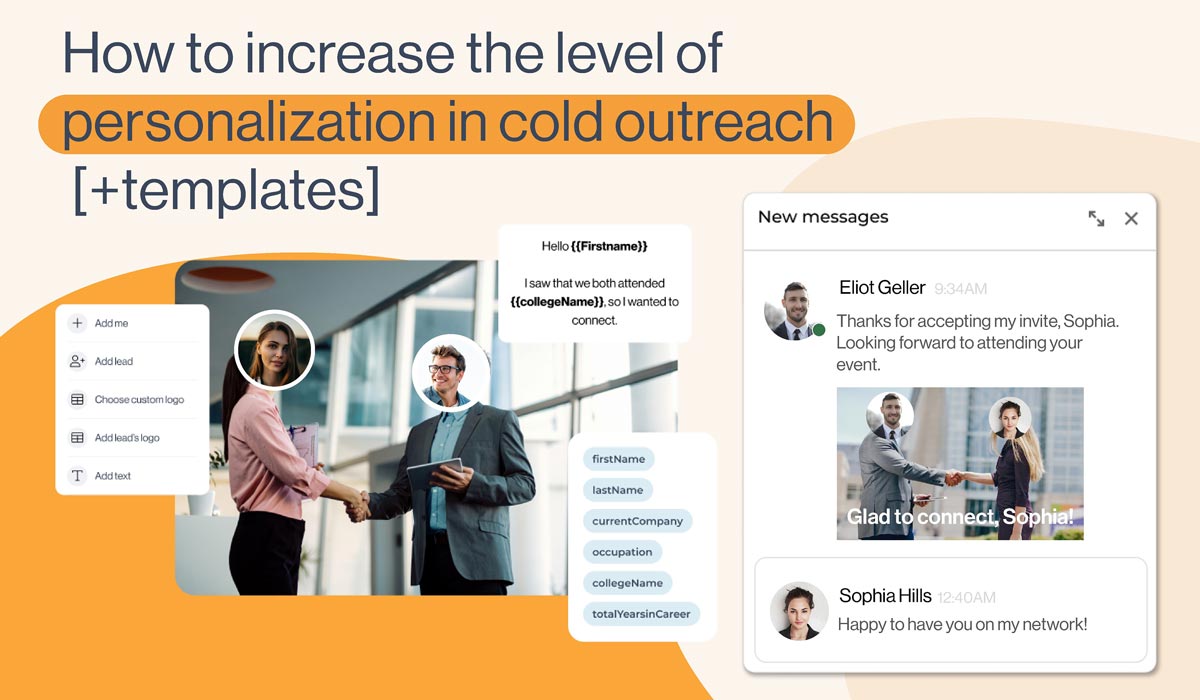
Humans are complex beings: We love, we care, we have jobs, hobbies, and the community we belong to. But when it comes to cold outreach and personalization, we suddenly forget everything we are and start thinking of ourselves as an automation machine offering a chocolate bar.
Maybe at the beginning of time, it was like that, alas in recent years, sales outreach is not about pushing a product in someone’s face to buy. Not anymore. The classic consumerism approach is long out of the picture. Nowadays, Sales is about personalization, providing a solution to someone’s problem and actually solving it, especially if we talk about B2B businesses.
That is why we need to remember who we are as humans first and know how to personalize our approach before we conduct the cold outreach itself.
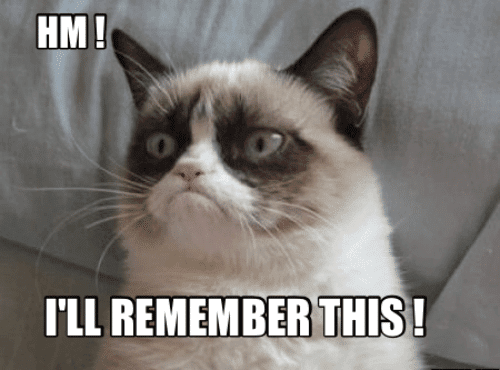
But before we share how to personalize your cold outreach for LinkedIn lead generation, let’s check if you are structuring your message correctly, whether you are using email or LinkedIn InMails and messages.
Cold Outreach Basics: How To Write An Email Or LinkedIn Message For Your Prospects
As we mentioned before, personalization is a big deal in cold outreach. It provides your prospect with the sense of caring and that you really wish to remove particular pain points. Let’s discover how to write email or LinkedIn messages that get results and determine where personalization is possible.
How To Structure An Email Or a Message
There are three main parts of any message you would want to follow:
- Hook
- Body
- Call to Action
While writing the hook for the cold outreach, you are still stating who you are and the reason why you are sending an email in the first place. Here you would need to add what about the prospect made you send the initial message.
Your hook can be created to invoke different actions and interests in leads. For example: one of the goals could be to wove your company throughout their personal thoughts and feelings. In this case whatever psychographics reason for outreach you pick, you need to relate it to your company, what it does, and how it solves the problem concerning value.
The body should emphasize what your company offers in terms of value and features. Keep in mind that the body is the least valuable for the prospect to read. They will first read who you are and what you want from them and then skip to the end of the message. If that lines up with them, they will read the body itself. Length-wise, it should not be longer than your Hook.
Call to Action aka CTA is the one-time request from the prospect to do the desired action, such as book a call or sign up for an event. This line should be the shortest, as opposed to others, and as direct as possible.
Your message length may vary depending on the channel of communication and character limit, but these are the main guidelines you should follow.
Personalization in Cold Outreach: Introducing Variables
If you are using Sales engagement tools, you’ve probably come across variables that help you create personalized outreach messages for your prospects.
If you are not using any tool mentioned above, placeholders or variables allow snippet information in your email or LinkedIn message to populate, making your emails resonate with the recipient. To put it simply, placeholders are parts of your messages that are customizable by certain personal aspects of the prospect, while the rest of your email can be uniform for all.
These placeholders, whether you are using a sales engagement tool or inserting them manually, differ in execution but can come in handy either way.
Example:
Let’s say you are using Skylead, a sales engagement tool to generate leads more effectively and personalize your cold outreach. As Skylead creates campaigns based on:
- LinkedIn and Sales Navigator Search Results
- Post engagement
- Lead list
- Your custom CSV file with the prospects’ information
It picks up the variables from the LinkedIn search results, so you do not need to search these manually (apart from the CSV file, in which case you need to make sure to include the leads' LinkedIn URL). The basic variables Skylead picks up, and you get to use in a message are the following:
- First name
- Last name
- Current company
- Years in current company
- Total career positions count
- Total years of experience
- College name
- Occupation

Thus making part of your email message look something like this:
Hi {{firstName}},
The reason for my outreach is that I’ve noticed you’ve been working as {{occupation}} in {{currentCompany}} for {{yearsInCurrentCompany}} years.
As I wish to learn more about being {{occupation}} and the business struggles they might experience, I would like to connect and chat with you...
Custom Variables
Now, apart from these standard variables, you can import your Custom Variables, as well. Custom Variables are the placeholders that you can create, state their purpose yourself, and import in Skylead as an example.
Whether in a sales engagement tool or manually inserted, Custom Variables can be:
Demographics - Variables such as age, gender, location.
Firmographics - Company name, size, performance, executive titles.
Psychographics - Classification by prospects’ opinions, values, attitude, interests.
If you wish to boost the process, you can use custom variables only in the outreach campaign created from a CSV file. Take a look at a quick guide on how to format and use custom variables for Skylead’s CSV campaign.

Custom Variables Examples for Your Message
The main part of the personalization process is finding as detailed information as possible on the prospect and putting it in the hook part of your message to catch their attention. That is why we are going to concentrate primarily on the variables for the intro of your message.
#1 Cold Outreach Hook: Prospects’ Original Content
When you first meet the person, do you instinctively like them more if they are interested in your thoughts, opinions, and what you created? Most of us will not admit it, but the answer to this question is a big YES (subconscious level included).
That is why the first type of placeholder you need to consider is the content they created by themselves, and you can find it on their LinkedIn page or company website. It usually includes the following:
- Webinars hosted
- Articles written
- Posts published
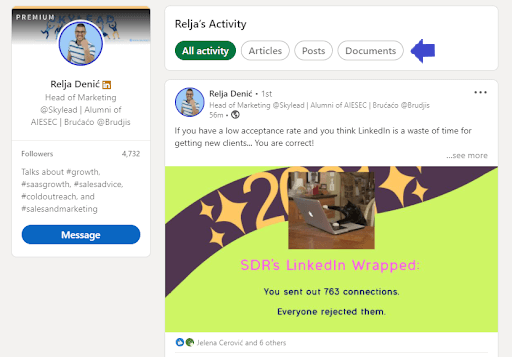
For the introduction, you need to tease out the need out of that content to hook them into what you do as a value. Choose the type of creation and put what you can offer through the content.
Example email using prospects’ original content as variable:
Hey {{firstName}},
The reason I’m reaching out is that I’ve read your recent article {{ArticleName}} where you emphasized {{TheirPoint}}. One sentence that really resonated with me was {{TheirSentenceWithPainPoint}}.
What if I told you that {{PainPoint}} is easily overcome by {{ProvideLightValue}}. So I was wondering, have you ever come across {{YourCompanyProduct}}?
Real-life example:
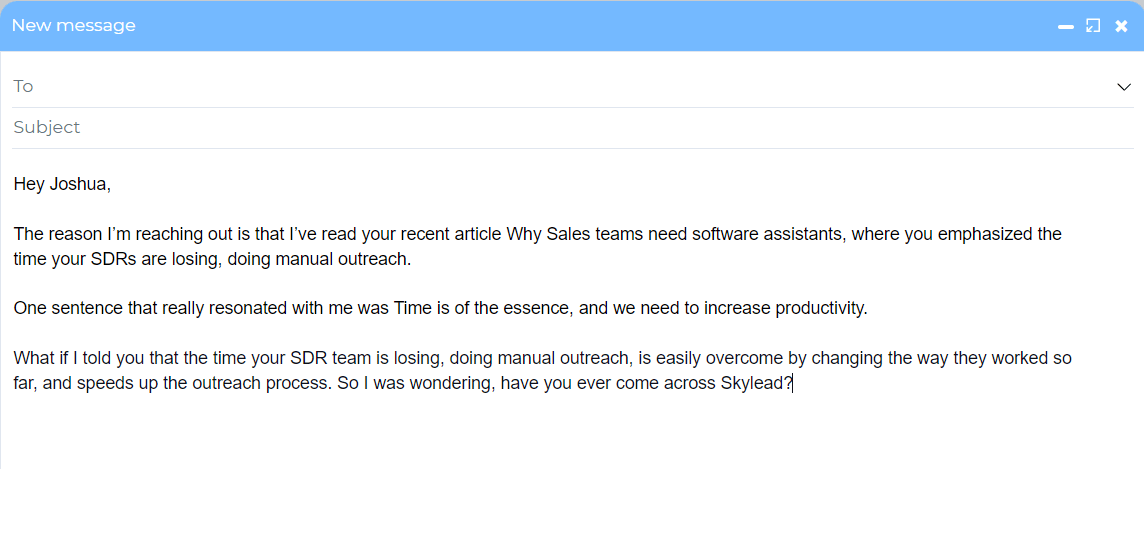
#2 Cold Outreach Hook: Content That Prospect Engaged With
This type of content implies any post, article, or video they liked or shared on LinkedIn but didn’t create themselves. Or you can use a webinar or event they attended. Although not as strong as the previous hook, the content they engaged with still shows your genuine interest and will provide you with an opportunity to relate it to your company.
Example LinkedIn message using content that prospect engaged with:
Hey {{firstName}},
I’ve noticed that you attended {{WebinarOrEventName}}.
What did you think about {{PainPoint}}? I was wondering how does {{currentCompany}} deal with such an issue?
Real-life example:
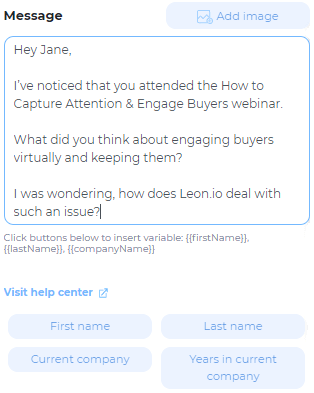
#3 Cold Outreach Hook: Using Prospects’ Self-Attributed Traits
Prospects' self-attributed traits are short sentences you will find on their LinkedIn profile, and they usually show what they are talking about themselves. The prospects view LinkedIn as a place where they can talk about their accomplishments, things they are skilled at, and what they like to do in the business world. You can easily find this information on their LinkedIn amongst:
- Profile line,
- Headline,
- Company description.
Here, they will communicate to the world what is important to them, therefore you can hook what your product/service does to this information.
Example LinkedIn message using self-attributed traits:
Hi {{firstName}},
I really liked your profile line about the {{HeadlineWithPainPoint}}. What I really liked was the sentence {{HeadlineWithPainPoint}}. What if you could make sure that {{PainPoint}} can be easily overcome?
Real-life example:
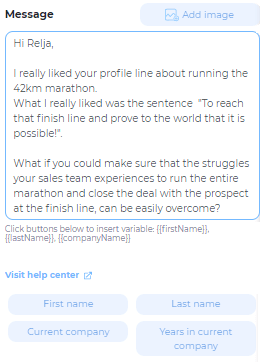
#4 Cold Outreach Hook: Prospects’ Background Information
If you cannot find any of the previously mentioned hooks, you need to dig a little bit deeper, as a private investigator would. Find schools they attended, hobbies, and personal interests. Again, the rule is that you have to link it back to your company.
Template Email message using background information:
Hi {{firstName}},
I noticed you enjoy occasional {{Hobby}}. You know what they say: {{QuoteAboutHobby}}.
Hiking is pretty much like {{department}}. What if I told you that {{Department}} process can be {{AtributesFromQuote}}?
That said, have you ever come across {{YourCompanyProduct}}?
Real-life example:
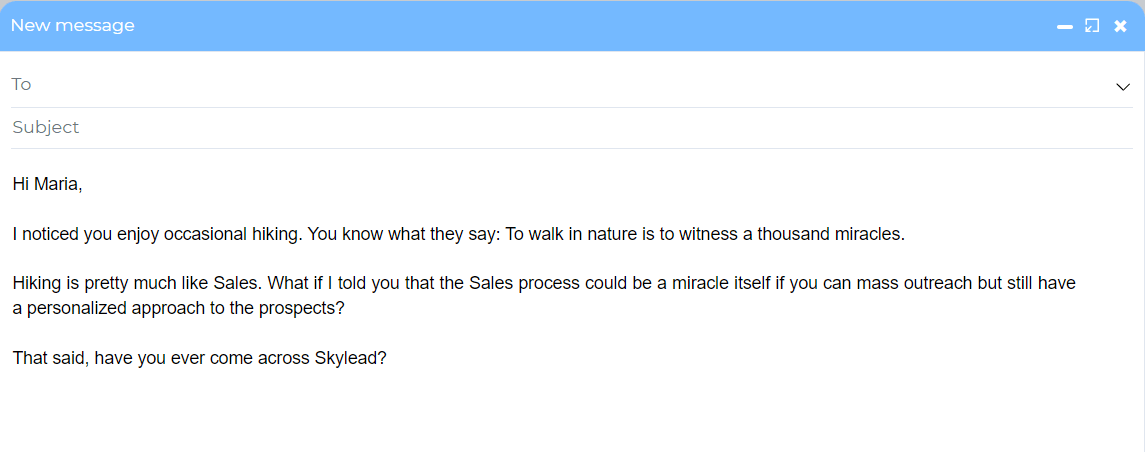
Pause - Outreach Variables effectiveness check-up
The reason why the mentioned hooks are so strong is that they all include psychographic variables. Psychographic traits are something that someone believes in, has an attitude for, or something that hits them more to the core. That is why they trigger the largest response rate as they are closer to the heart.

And continue…
#5 Cold Outreach Hook: Company Information
Unlike psychographic variables, the following personalization placeholders are classified as firmographics. They include information such as:
- Merger and Acquisition information,
- Growth information,
- Website language,
- Hiring they have,
- Posts.
These variables are the least effective on the list. Nonetheless, if you say only one thing about their company specifically, they will feel more special as they know you are talking ONLY to them.
Using this kind of information, you would like to be as detailed you can but briefer in character length.
Template Email message using background information:
Hi {{firstName}},
I noticed your company grew {{CompanyStatistics}} in the last year. Congrats!
I understand that as {{occupation}} you must have even more tasks when it comes to {{PainPointProcess}}.
What if I told you that your life as {{occupation}} can be easier so your {{CompanyStatisticsBoosted}}?
I was wondering, have you ever heard of {{YourCompanyProduct}}?
Real-life example:
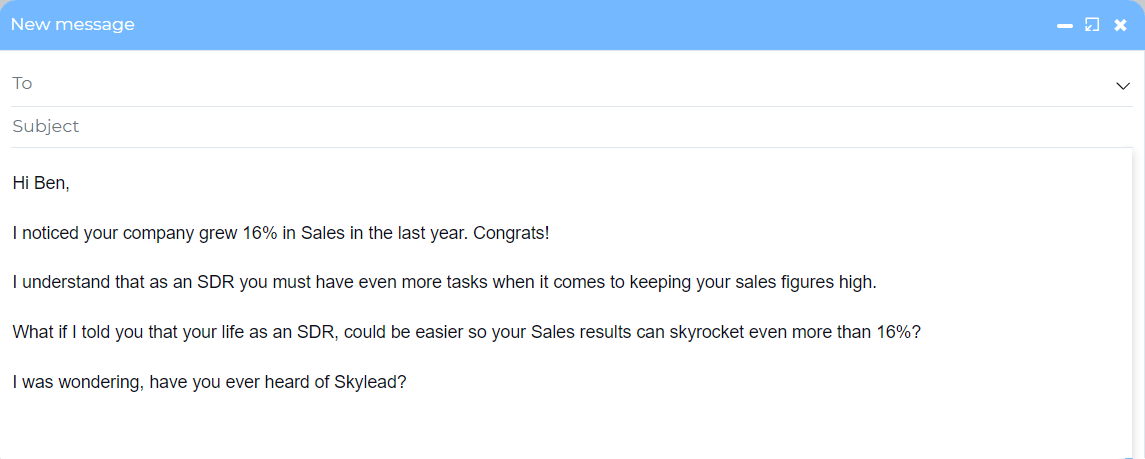
#6 Cold Outreach Hook: Personalized Intro
If you find that previous variables might be a little more in-depth than you are willing to go, you can help yourself with the previously mentioned concept ideas, but use one variable only. To put it simply, you can use a personalized intro that changes depending on the prospect, while the rest of your email or the LinkedIn message stays the same for everyone.
Template email message using personalized intro:
Hey {{firstName}},
{{PersonalizedIntro}}.
That said, I was curious if you are using a solution for your cold outreach?
I would love to show you a solution that can combine Email and LinkedIn with a hyper-personalized approach that will help you book 30+ additional meetings per month and keep your pipeline full.
Real-life example:
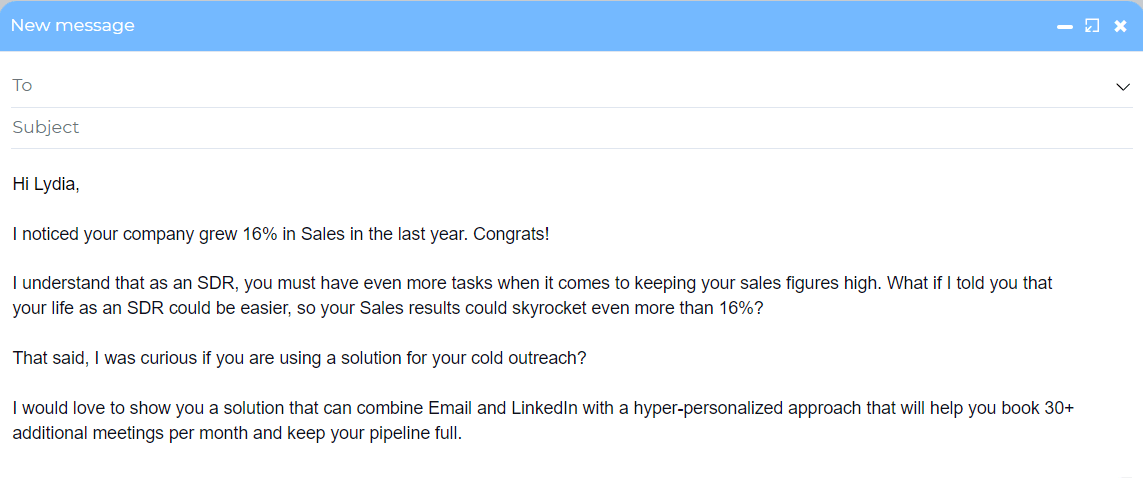
Bonus: Short Variables
As additional placeholder ideas that you can use for personalization, take a look at other custom variables that we singled out.
- {{TeamMemberName}} - Using the leads’ colleague’s name will create a sense of familiarity (combination of firmographic and psychographic).
- {{SalesPitchAccordingToTheIndustry}} - You can create a short pitch block in your message according to the prospects’ industry with the main pain points and values demonstrated.
- {{BirthdayDate}} - If listed on their LinkedIn profile, you can extract this information and prepare a special pre-birthday gift as a Pain Point relief for their business needs.
Top The Cold Outreach Up a Notch With Other Type Of Personalization
The one thing people do not use more often but should integrate into their cold outreach is personalized GIFs and Images. Trust us - you will get a far better response rate.
A buying experience personalized to the prospects’ profile image, apart from custom variables, is perfect for cutting through the noise of other emails and reaching out.
For example, Skylead, as a sales engagement tool, likes to get personal, offering native GIFs and images personalization with prospects profile image or company logo. Of course, you can do this manually as well, but the point stays the same: additional and creative personalization will get you far in establishing the relationship with the lead.
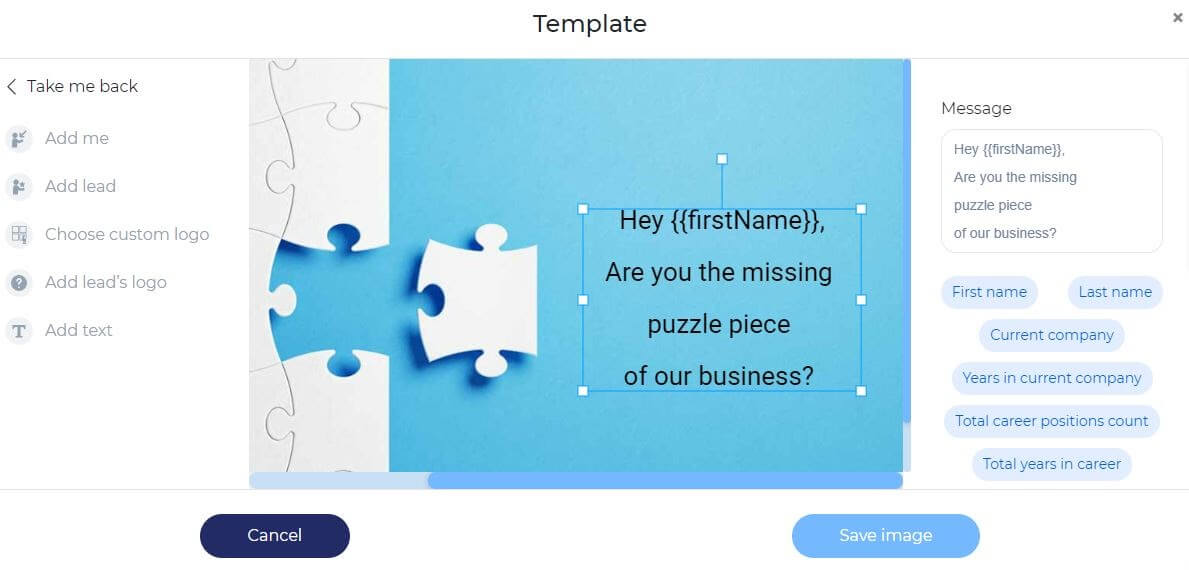
Summary
To sum up, here are all custom variables ideas that have been used throughout the text:
| Placeholder description | Variable name |
| Authored content chosen | {{WebinarName}}, {{ArticleName}} |
| What stood out for you in particular content | {{StoodOutSentence}} |
| Day when you saw the authored content | {{ContentSeenDate}} |
| Attended webinars or events | {{WebinarOrEventName}} |
| LinkedIn headline or profile about section with pain point | {{HeadlineWithPainPoint}} |
| Prospects’ Interests in the Hook part of the email | {{Hobby}}, {{QuoteAboutHobby}} |
| Company department for which you created the product/service | {{Process}} |
| Firmographic statistics that is highly specific about somebody’s company | {{CompanyStatistics}} |
| Using the colleague’s name in the Hook part of the email | {{TeamMemberName}} |
| Custom sales pitch according to the industry for the body of the email | {{SalesPitchAccordingToTheIndustry}} |
| For the Hook part of the message | {{BirthdayDate}} |
| The entire introduction created for the individual lead, while other parts stay the same | {{PersonalizedIntro}} |
LinkedIn prospecting and outreach is a necessity. Done correctly, you will improve conversion, customer relationship, retention, sales figures and KPIs.
The key to success lies in personalizing your outreach and building a relationship with your leads. Remember, they are humans too.
So start creating a targeted outreach strategy and show your leads that you’ve actually done the research, and that you are genuinely interested to help. Empathy is everything.
If you wish to boost and hyper-personalize your cold outreach, check out how Skylead works, come, say hi and try it out free for 7 days.


